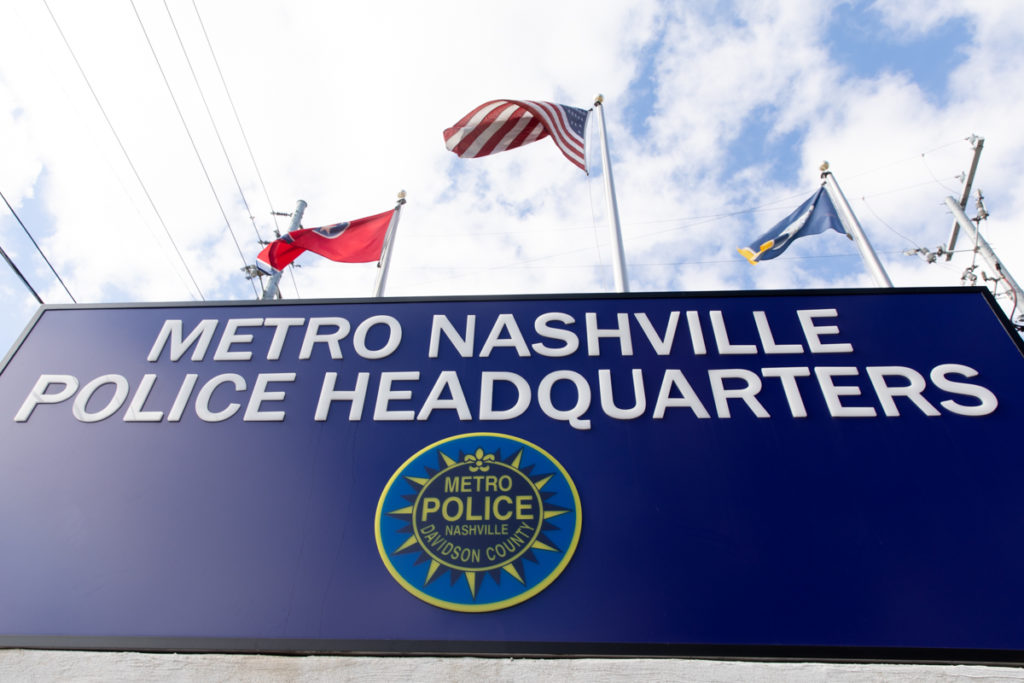
Metro Nashville Police Department officers have shot 10 people in 2021 — seven fatally.
That far surpasses the total in any year since the department started tracking these incidents in 2005. And it doesn’t count two additional instances when young men shot and killed themselves during encounters with officers.
Here’s a summary of each shooting and a few noteworthy trends.
Lamon Witherspoon: Nonfatal
On Jan. 27, a group of officers from a new investigative team pulled up to a parking lot in unmarked cars and surrounded a stolen vehicle. They were hoping to arrest the man inside the car — Lamon Witherspoon — because they believed he had robbed a restaurant a few days earlier.
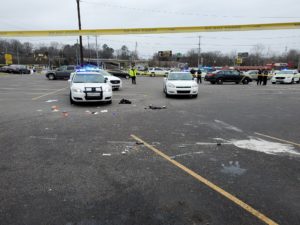 Courtesy Metro Nashville Police Department
Courtesy Metro Nashville Police Department Officers from a recently formed intelligence team conducted the “vehicle jam” that ended in a shooting in January.
The officers were using an uncommon tactic called a vehicle jam, which requires special training. Only a handful of units are authorized to use the method, when attempting to arrest someone they’re worried will try to flee.
Police say the officers shattered the car’s windows and told Witherspoon to surrender. Then, two allegedly saw a gun in his hand.
Officer Wesley McClelland shot Witherspoon in the head and the hip. Witherspoon was treated at the hospital and then booked in jail on aggravated assault and aggravated robbery charges.
McClelland had fatally shot another man in 2016 and was cleared of wrongdoing in that case. His department records show he has been investigated for using force more than a dozen times since joining the department in 2012, but the force has been deemed justified in each case.
Nika Holbert: Fatal
On March 12, Officer Joshua Baker pulled over a black Chevrolet Camaro after running the license plate and seeing that the owner had six outstanding warrants. When a woman got out of the car, Baker realized she was not the owner.
Body camera footage shows the woman, Nika Holbert, saying she’s confused as to why she’s been stopped. But she allows Baker to search her bag, where he finds a small baggie with marijuana and another with white powder.
 Screenshot Courtesy Metropolitan Nashville Police Department YouTube
Screenshot Courtesy Metropolitan Nashville Police Department YouTubeDash camera footage shows an interaction between Officer Joshua Baker and Nika Holbert, moments before a shootout.
While this is happening, the woman calls her mom and lights a cigarette. “You’re scaring me,” she tells the officer. After he finishes his search, he tells her to “do me a favor” and turn around.
“Don’t put me in handcuffs,” Holbert tells him. “I haven’t done another wrong.”
She grabs her bag, runs around the car and gets into the driver’s seat. Baker Tases Holbert as she screams for help. Then, she reaches for a gun and fires at the officer. He fires back.
Baker was wounded but survived. Holbert drove a short distance, crashed her car and was pronounced dead at the hospital.
Melissa Wooden: Nonfatal
Later in the day on March 12, officers responded to a home on Greer Road. In a recording released by MNPD, a dispatcher says a woman there wants to harm herself and hopes the police will come and shoot her.
Three officers arrived and found Melissa Wooden in the yard, holding a pickaxe and a baseball bat, saying she was “about to go crazy” and that she didn’t want to talk.
In body camera footage shared with reporters, Officer Ben Williams tries to ease Wooden’s anxieties. He asks her if she’s taken anything and assures her that “nobody is going to kill you.”
The conversation continues calmly for a while, until Wooden’s mom arrives on an electric scooter and tells the officers that her daughter is mentally ill and that “she’s trying to get cops to kill her.” After a few moments, the mother starts moving toward Wooden and telling her she’s “going back to the hospital.”
Wooden pulls the pickaxe and bat behind her shoulder, and Williams tried to subdue her with a Taser. But when she starts moving toward him, another officer fires his weapon.
Wooden was treated at the hospital for nonfatal injuries.
Marvin Veiga: Fatal
Around midnight on April 24, police say Officer Christopher Royer pulled over a white Mercedes on Clarksville Pike, because its license plate didn’t match the car description on file. Moments later, a passenger got out of the car.

“No officer wants to deal with this situation,” Chief John Drake tells reporters at a press conference after the April shooting.
Body camera footage shows Royer telling the man to get back in the car. The officer also notices a knife and orders him to drop it.
The man, identified later as Marvin Veiga, next tries to get into an unoccupied patrol car. He then gets back out and runs through the street.
“What are you doing? Drop the knife!” the officer yells. “I don’t want to shoot you!”
But as Royer continues to urge him to drop the knife, Veiga runs toward him. Royer fires, killing him. Veiga was wanted for murder and gun charges in Massachusetts.
Jacob Griffin: Fatal
On May 1, a mother called 911 to tell dispatchers that her son, who she said had schizophrenia and was living in a homeless encampment, had texted her that he planned to kill her and others. In a recording released by police, she says her son, 23-year-old Jacob Griffin, has a gun and has texted her photos of bullets.
“He is armed and I personally would consider him dangerous, but he has never actually been violent,” the mother tells dispatch. “I really don’t want the police to kill him, but I don’t want him to kill anyone else, either.”
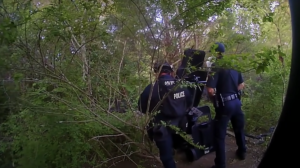 Screenshot Courtesy Metropolitan Nashville Police Department YouTube
Screenshot Courtesy Metropolitan Nashville Police Department YouTubeBody camera footage shows officers negotiating with Jacob Griffin during an hourslong standoff in the woods.
Two patrol officers found Griffin in the woods behind a Goodwill store where he used to work. He had a gun.
Police say the officers tried to get his hands off the gun by Tasing him, but it didn’t work. Then, a team of SWAT officers and crisis negotiators arrived. Edited body camera footage released by MNPD included excerpts of an hourslong standoff with Griffin. Some officers had rifles drawn. Police say mental health counselors were also at the scene, and officers tried to convince Griffin to talk to them.
After Griffin fired a shot, officers tried again to get his hands off the gun with less-lethal force, including a K-9. But when they sicced a dog on Griffin, he fired his gun again, and Officer Matthew Grindstaff shot back.
Antonio King: Fatal
Before 6 a.m. on Aug. 3, Antonio King came to work at a SmileDirectClub facility in Antioch with a gun. Surveillance footage show him firing into the building. He injured three employees.
Officers responded to the scene and found King on the sidewalk. Body camera footage shows them shouting at him to “drop the weapon” as he continues down the sidewalk and into the street.
When King appears to lift his gun, officers Cherelle Kinchloe and Dylan Ramos fire their weapons. As King flails on the ground and officers ordered him not to move, they handcuff him. Then, several begin to render aid.
King did not survive.
Daniel Turney Crowley: Fatal
In the early morning hours of Aug. 11, a K-9 officer was checking on businesses in the West Precinct when he noticed a car sitting outside a cellphone store that he thought looked suspicious.
 Screenshot Courtesy Metropolitan Nashville Police Department YouTube
Screenshot Courtesy Metropolitan Nashville Police Department YouTubeIn dash camera video, Officer Richard Clemmons approaches an SUV while checking on businesses during his overnight shift.
Police video shows Officer Richard Clemmons approaching the car and repeatedly telling the driver, Daniel Turney Crowley, to put down a knife.
“Put the knife down, bro,” Clemmons says, his gun drawn. “It’s not worth it, man.”
As two more officers arrive on the scene, the driver gets out of the car and starts running toward Clemmons. All three officers fire, killing him.
Adrian Cameron: Fatal
On a Saturday night in mid-September, officers from MNPD’s SWAT team went to the Days Inn hotel on Percy Priest Drive to question a man they thought might have information about a recent homicide. Police say Adrian Cameron had a warrant out for his arrest and was expected to be armed.
Video shows an armored vehicle and officers in tactical gear surrounding Cameron’s room and ordering him over a loudspeaker to come out. After some time, Cameron enters the doorway to his room with a rifle and opens fire. Three officers shoot back.
Cameron was pronounced dead at the hospital.
Rod Reed: Nonfatal
On the afternoon of Dec. 7, a school resource officer pulled up to the scene of a car crash on his way home from work. Body camera footage shows Officer Byron Boelter approaching one of the cars, to see if anyone is inside.
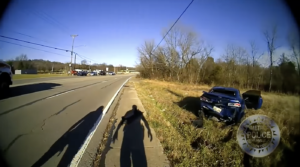 Courtesy Metro Nashville Police Department
Courtesy Metro Nashville Police Department Body camera footage shows Officer Byron Boelter approaching a car involved in a crash, seconds before he fires his weapon.
A young man can be seen leaning through the open passenger door as if to retrieve something when Boelter looks through the window on the driver’s side and tells him to “leave that stuff in there, man. Just go ahead and go.”
The young man walks away. Then 20-year-old Rod Reed, walks up and also tries to retrieve something from inside. Boelter tells him to leave it.
But Reed keeps reaching toward the dashboard, where there’s a gun. Boelter immediately fires, shooting him in both legs.
“Why’d you reach for it kid?” Boelter asks.
“I was trying to get it out the car, sir,” Reed tells him.
Reed was treated for nonfatal injuries at the hospital and then booked in jail on federal firearm and drug charges.
Unidentified 39-year-old: Fatal
Early on the morning of Dec. 16, officers responded to a call about an abandoned car on West Old Hickory Boulevard in Madison. The officers heard gunshots and saw a man in the woods on the side of the road.
Excerpts from body camera footage shows the officers telling the man to put his hands up and walk backward toward the road.
“You will not be harmed if you come out peacefully,” one says over a loudspeaker.
Police say the officers waited about 30 minutes for the man to surrender and that he did eventually get on the ground. But they kept hearing gunshots and weren’t sure if the man was shooting toward them.
Then, the department says, he fired two shots in front of them. Officer Ricardo Cruz fired back with a shotgun and killed him.
Different circumstances, but some common themes
After the most recent shooting by police, MNPD spokesperson Don Aaron said at a press conference that “each police shooting stands on its own, as far as the facts are concerned.” Aaron also said officers have fired their weapons so many times because they’ve repeatedly been put in dangerous situations.
But while the details vary, there are several common trends.
Trend #1: Weapons
Each time officers shot someone in 2021, the person they shot was armed. In two cases, the people had knives and in one instance the person had a baseball bat and a pickaxe. In all the other cases, officers shot someone with a gun.
This comes as police face a heightened risk of encountering someone with a firearm. Gun sales are surging, both in this state and nationwide. The Tennessee Bureau of Investigation processed the sale of over 800,000 guns last year — more than double the number a decade ago.
The state also has a new law that allows almost any adult to carry a gun without a permit. On top of that, homicides are spiking here in Nashville, just like they have been in many cities across the country during the pandemic.
MNPD says officers receive extensive training to deal with people who are armed and that they have also learned about Tennessee’s new constitutional carry statute. The department’s training commander has also said he considers changes to the curriculum after each shooting. But the historic number of deadly force incidents raises questions about how well the use-of-force training is working to prevent violence against civilians (MNPD disputes this).
Trend #2: Mental Illness
In several cases this year, police have tried to reason with someone seemingly in the midst of a mental health crisis.
In such instances, the department often calls in its SWAT team, especially if the person is armed. Crisis negotiators are also sometimes brought in to help.
Those officers use a range of tactics to try to convince people to cooperate. But sometimes that includes shouting commands and wearing tactical gear, which some policing experts say can escalate the situation.
Many community members have urged the department to send unarmed mental health professionals instead. And this year, MNPD launched a pilot program that pairs officers with counselors from the Mental Health Cooperative for a co-response to some calls.
The program started in two precincts, and MNPD hopes to expand it after studying the pilot’s success.
Trend #3: Body Camera Footage
After years of delays, the police department has finally equipped all its officers with body cameras.
 Screenshot
Screenshot Body camera video shows Officer Byron Boelton firing his gun less than a minute after pulling up to a car crash.
In the past, it was hard to pin down exactly what had happened when police shot someone, unless the interaction happened to be caught on surveillance cameras. But now, in almost every case, there’s minutes or even hours of body camera footage.
This footage is often clearer than surveillance video, and it also has sound. However, access to body and dash camera footage has varied.
At first, the department was inviting reporters to MNPD headquarters to watch all the footage and then sending them home with footage on a flash drive. Then, officials started releasing what they call “critical incident briefings.”
 Screenshot
Screenshot Police spokesperson Don Aaron narrates a “critical incident briefing,” which includes 911 tape and edited body camera footage from a shooting by police in May.
These videos are narrated and edited. They sometimes include 911 calls or surveillance footage from the scene, as well.
But parts of the encounter are often left out. MNPD has declined WPLN News’ records requests for copies of body and dash camera footage while investigations are underway.
Chief John Drake has said he’s committed to transparency and has taken multiple steps to release more information to the public, including sharing body camera footage and publishing a data portal. The department manual says footage should be withheld in the case of a pending criminal investigation, but can be shared if the district attorney’s office authorizes its release.
Trend #4: Investigations
After each shooting, at least three investigations occur.
The police department conducts an internal review of the officers’ actions, to see if they were following policy. All those investigations are still pending, according to MNPD.
 Screenshot Courtesy Metro Nashville YouTube
Screenshot Courtesy Metro Nashville YouTubeMetro Nashville Community Oversight Executive Director Jill Fitcheard speaks at a monthly Community Oversight Board meeting in December.
The civilian-run oversight agency, Metro Nashville Community Oversight, conducts its own review, also to evaluate if officers followed proper protocols. They’re facing a a backlog, so those investigations are also still pending.
In addition, the TBI investigates each shooting as a potentially criminal case. They pass their findings to the DA, to decide if anyone who fired their weapon broke the law.
The TBI has completed their investigations in all but the three most recent shootings, and the district attorney’s office has not announced any intentions to prosecute. Criminal charges are incredibly rare for shootings by police, especially when the person they shoot is armed.
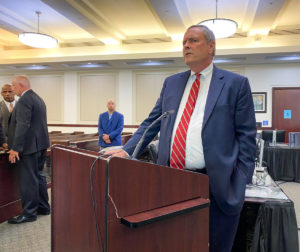 Samantha Max WPLN News
Samantha Max WPLN NewsGlenn Funk tells reporters that the prosecution of Andrew Delke was “not a slam dunk case” after a plea hearing July 2, 2021.
Earlier this year, the first Nashville officer ever charged with murder for an on-duty shooting was supposed to stand trial. But the DA abandoned the case just days before jury selection was scheduled to begin, instead offering former officer Andrew Delke a plea deal for a lesser charge. Delke was sentenced to three years in the local jail for voluntary manslaughter.
At a plea hearing, Delke said he hoped his case would “contribute positively to the much-needed discussion about how police are trained and how we as a community want police officers to interact with citizens.”

